Comprehensive Guide to Breeding Canaries

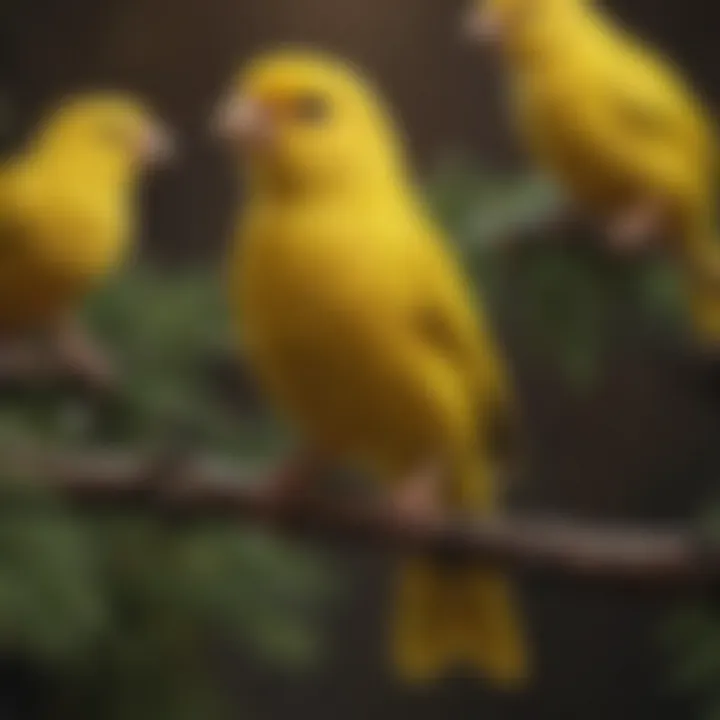
Intro
Breeding canaries can be a rewarding pursuit, often filled with as much joy as there are considerations tied to the well-being of your feathered companions. Understanding their behavior, care, and the complexities of breeding can not only enhance your experience but also ensure that the birds thrive in a loving environment. Whether you're a parent introducing a child to the wonders of nature or a seasoned bird enthusiast, there's much to explore.
This guide delves into the nuances of canary breeding, encompassing everything from their quirky habits to proper care and enrichment activities, all while keeping an eye on health and genetics. Let's take a deeper look.
Understanding Your Pet
Pet Behavior Basics
Canaries are not just beautiful to look at; they also have rich personalities worth getting to know. Understanding their behaviors is like unlocking a door to a vibrant world. For instance, have you noticed how they sing? Each song serves as a communication tool, often conveying their mood or alertness regarding their environment. You might find that during certain seasons, particularly in spring, their vocalizations become more pronounced, which is part of their natural breeding behavior.
Common Breed Characteristics
Canaries come in various breeds, with each exhibiting unique traits. The most common among these are the American Singer, known for its melodious tunes, and the Yorkshire, recognized for its robust body and striking crest. Depending on the breed, characteristics such as color and size can vary significantly.
Species-Specific Needs
When discussing canaries, it's important to remember that they thrive under certain conditions. A spacious cage with proper bar spacing and substrates for foraging are crucial. Canaries also prefer a varied diet, largely consisting of seeds but should include fruits and vegetables to ensure they receive necessary nutrients.
Pet Care and Maintenance
Feeding Guidelines
Feeding your canary is not a one-size-fits-all. A balanced diet rich in seeds, pellets, and occasional greens helps ensure their health.
- Pellets: These are often fortified with vitamins.
- Sprouted seeds: They’re nutrient-dense and provide a natural treat.
- Fruits: A little piece of apple or carrot can add excitement to their meals.
Grooming Essentials
While canaries are fairly low-maintenance, they do need occasional grooming. Regularly checking their feathers and beaks is essential. They may require a gentle scrub to remove any debris lodged in their plumage. Sometimes, a shallow bath or mist can help them clean themselves, promoting overall hygiene.
Hygiene Practices
A clean environment translates to healthy birds. Regularly change out the bedding, clean their food and water dishes, and ensure the cage is free from droppings and uneaten food.
Training and Development
Basic Commands and Skills
Training a canary may not be as conventional as other pets, yet engaging them in basic commands can enhance their interactions. Simple whistle commands can be taught to encourage quoting or returning to a perch.
Behavioral Training Techniques
Behavioral training isn't solely about commands; it's also about understanding their instincts. Using positive reinforcement—think of it as a reward system—is effective. For example, when they sing, provide praise or a treat; this reinforces their natural tendencies to vocalize without forcing them.
Addressing Common Behavior Issues
Sometimes feisty, canaries can exhibit behaviors such as excessive noise or reluctance to interact. Identifying the triggers of these behaviors is key. It may be environmental stressors or boredom. Consider enhancing their space with toys or more social interaction options.
Health and Wellness
Routine Vet Check-ups
Check-ups at an avian vet are vital. Even if your canary seems healthy, preventive care plays a crucial role in early illness detection.
Vaccination Needs
Canaries are generally resistant to many diseases but keeping them up to date with necessary vaccinations under a vet’s advice is prudent.
Recognizing Signs of Illness
Peculiar behaviors can often be the first indicators of illness. Look for signs like changes in eating habits, lethargy, or unusual droppings. If you spot anything off-kilter, consult your vet without delay.
Enrichment and Activities
Indoor vs. Outdoor Activities
Canaries are social creatures. While some enjoy the safety of indoor environments, others benefit from short supervised visits outside. When outdoors, ensure the area is secure from potential predators.
Interactive Toys and Games
Interactive toys stimulate their minds. Toys that mimic foraging, like blocks or hanging greens, can keep your canary busy for hours.
Socialization Opportunities
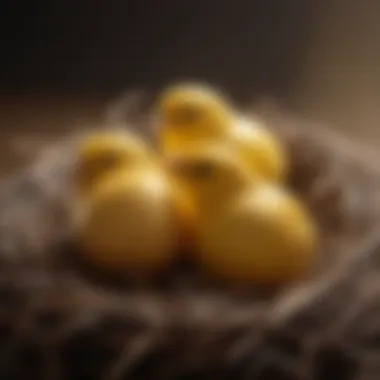
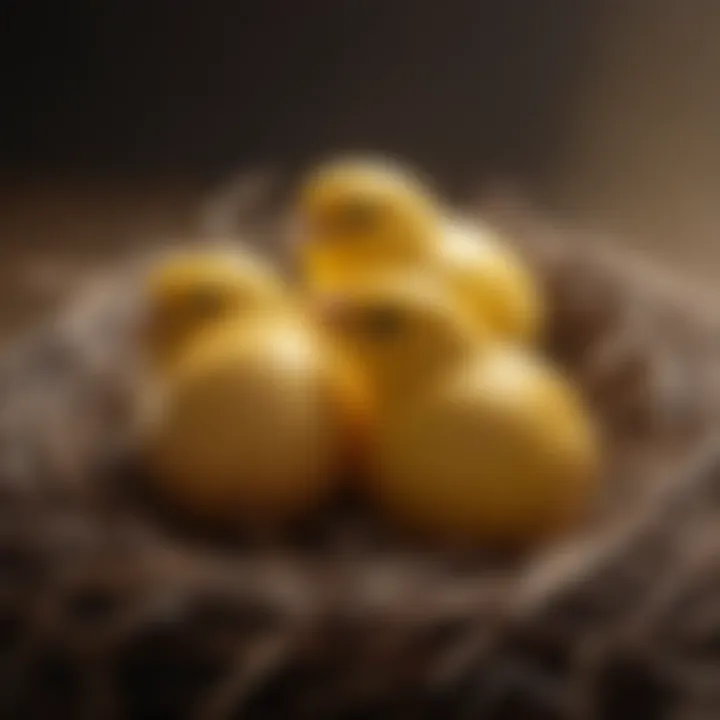
Consider introducing your canary to other birds. Just be cautious, as it’s important to monitor interactions to prevent conflicts. Regular human interaction also enhances their comfort with companionship.
"A well-cared-for canary is not just a pet but a vibrant member of the family, bringing joy and song that can fill a room."
Embarking on the journey of breeding canaries requires knowledge and vigilance, ranging from understanding their behavior to ensuring proper care and creating an enriching environment. By addressing each aspect, you set the stage for a healthy and harmonious life for both you and your new musical companions.
Prolusion to Canary Breeding
Breeding canaries is not merely a hobby but an intricate endeavor that weaves together our understanding of avian biology, genetics, and environmental influence. It's a pursuit that demands patience and careful planning, but the rewards can be substantial. Engaging in this activity not only allows one to observe the beauty of these feathered companions but also to contribute to the preservation and enhancement of their lineage.
Historical Significance of Canaries
Canaries have been companions for centuries, their cheerful tunes echoing through homes and hearts alike. Originating from the Canary Islands, these small birds were first cultivated by European breeders in the 17th century. They were prized not just for their melodic sounds but also for their stunning colors and diverse patterns. Through selective breeding, canaries were slowly transformed from their wild counterparts into the myriad varieties we see today—each accentuating distinct traits that appeal to enthusiasts.
Historically, canaries served practical roles as well; miners, for example, used them as indicators of air quality due to their sensitivity to toxic gases. Thus, canaries were entrusted with lives, reflecting their significance in both domestic settings and challenging environments.
"To understand the past is to prepare for the future. Breeding canaries includes celebrating their rich history while ensuring their survival in modern times."
Purpose of Breeding Canaries
The reasons behind breeding canaries are as varied as the birds themselves. For many, it starts with the joy of music. Breeders aim to enhance the singing capabilities of these birds, focusing on pitch, clarity, and duration. The melodious warbles of a well-bred canary can brighten any day, creating a delightful ambiance.
However, there's more to canary breeding than aesthetics and sound. Breeding can also serve as an important means of maintaining genetic diversity. Through careful selection, breeders can reduce the risk of hereditary diseases and abnormalities that can arise from a limited gene pool.
Furthermore, breeding allows aspiring ornithologists to explore their interests deeply, learning about genetics, proper nutrition, and the behavior of these charming creatures. It becomes an educational journey where each step taken toward hatching a new chick not only fosters a love for animal husbandry but enhances one's understanding of ecological relationships.
In summary, breeding canaries is a commitment filled with passion and purpose. It requires dedication and knowledge, rewarding breeders with a deep sense of fulfillment and pride in creating healthy, vibrant birds that sing their praises for generations.
Selecting Breeding Stock
Choosing the right breeding stock is absolutely crucial when delving into canary breeding. It influences not only the success of breeding efforts but also the overall health and temperament of future generations. This process requires thoughtful consideration and a discerning eye, as the traits of both parents will significantly affect the offspring. By taking the time to select quality stock, breeders can enhance a variety of desirable characteristics, whether they be physical traits like color and size or behavioral traits like song and sociability.
Understanding Canary Varieties
Canaries come in a multitude of varieties, each boasting unique characteristics. Ranging from the vibrant song canaries to the spectacular color canaries, knowing these varieties is key.
- Song Canaries: Breeds like the American Singer and Yorkshire are celebrated for their melodic abilities. If a breeder aims for offspring with excellent singing capabilities, selecting a male from a high-quality song lineage is paramount.
- Color Canaries: Some popular color varieties include the Agate, Lizard, and Fife. Here, one must pay attention to pigmentation, as distinct colors can make a world of difference in appearance.
When understanding canary varieties, remember that genetics play a huge role. Picking parents that reflect the desired traits often means digging into their lineage to see how those traits have carried through many generations. It is not unusual for unexpected patterns to arise if the parentage is not thoroughly analyzed.
Assessing Genetic Quality
Once you’ve identified suitable varieties, assessing genetic quality is next on the agenda. Consider this step akin to reading the fine print before signing a contract. A sound genetic background helps ensure that you’re not setting yourself up for challenges down the line. Here are a few points to ponder:
- Lineage History: Breeders should look for a clear lineage, avoiding birds from common bloodlines to prevent issues like inbreeding. Healthy genetic diversity can bolster the chances of producing strong, vibrant chicks.
- Trait Consistency: Evaluate how consistently certain traits are passed down. If color or song varies widely in a bloodline, it might lead to unpredictability in the offspring’s qualities.
- Testing for Traits: In a more advanced stage, genetic testing might reveal certain predispositions, which can help in selecting the most fit breeding stock.
As with anything, it helps to do a bit of homework. Research reputable breeders, maybe even networking with others in the community, to gain insight on which characteristics are most desirable.
Health Screening Considerations
Now that you’ve pinpointed the genetic aspects, health screening becomes the next layer in the process of selecting breeding stock. It’s no use breeding a canary that has underlying health concerns. Regular check-ups and health screenings play a vital role in ensuring that both breeding pairs are fit to mate. Here are factors that shouldn’t be overlooked:
- Physical Appearance: Birds should exhibit healthy plumage, clear eyes, and a strong physique. A dull-looking bird can signal health issues.
- Behavioral Indicators: Conducting behavioral assessments is just as important. A timid or overly aggressive bird may not be ideal for breeding.
- Disease Testing: diseases like avian pox and candidiasis can wreak havoc on a breeding program. Testing for common avian ailments before breeding ensures that the birds aren’t carrying any hidden threats that could jeopardize their young.
Always consult with an avian veterinarian for comprehensive health assessments before bringing birds into your breeding program.
In summary, selecting breeding stock requires a fine balance of aesthetics, genetic rooting, and health considerations. The successful breeder will invest time in research and community collaboration, ultimately leading to healthier generations of canaries that can thrive and perhaps even sing a little sweeter.
Breeding Techniques
Breeding techniques are the cornerstone of successful canary breeding. Understanding various methods empowers breeders to produce healthier birds with desirable traits. This section dives into a few essential aspects—natural versus artificial breeding, understanding breeding cycles, and the nesting requirements for canaries. Each subheading will furnish insights that cater not just to the novice, but also those looking to refine their established practices.
Natural vs. Artificial Breeding
When it comes to canaries, the debate between natural and artificial breeding is significant. Natural breeding is quite straightforward: you introduce a male and a female in a suitable environment and let nature take its course. This approach often leads to a more instinctual bond between the birds, potentially results in stronger offspring, and allows the parent birds to care for their chicks instinctively.
On the other hand, artificial breeding involves human intervention. This might include controlled insemination techniques or selective pairing practices. Breeders may choose this route if they aim to enhance specific traits, such as color or song. While this method can yield desirable results, it does come with responsibilities, including the need to monitor the health and well-being of both the birds and their chicks. As with everything in life, both methods have their pros and cons, and it ultimately depends on the breeder's goals and the level of care they are willing to offer.
Understanding Breeding Cycles
Timing is everything in canary breeding. Understanding the breeding cycle is crucial for success. Canaries typically breed during spring and summer when days are longer and daylight stimulates their reproductive hormones. Familiarizing yourself with their cycle can lead to higher hatching success and healthy chicks.
The cycle begins with courtship behaviors, followed by the female laying eggs—usually 3 to 5 in a clutch—after which she incubates them for about two weeks. The inferring it might take some time for the male to woo the female might be all part of the process. Each phase holds its delicate balance, requiring attention from the breeder. For example, if you notice the female isn't interested in nesting or has skipped a cycle, it could be due to environmental factors or health issues. Keeping a close watch on their behavior and condition will help in identifying any potential hiccups in the natural rhythm.
Nesting Requirements
Creating a conducive nesting environment is vital for canary breeding success. The nest should be safe and comfortable, as it's where the female will lay and raise her chicks. Appropriate nesting materials, such as soft grasses, feathers, or shredded paper, are essential too. It's crucial to avoid any materials that might be harmful or toxic to the birds.
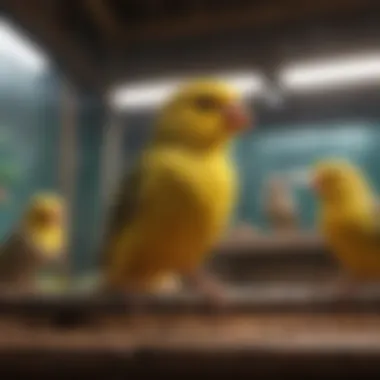
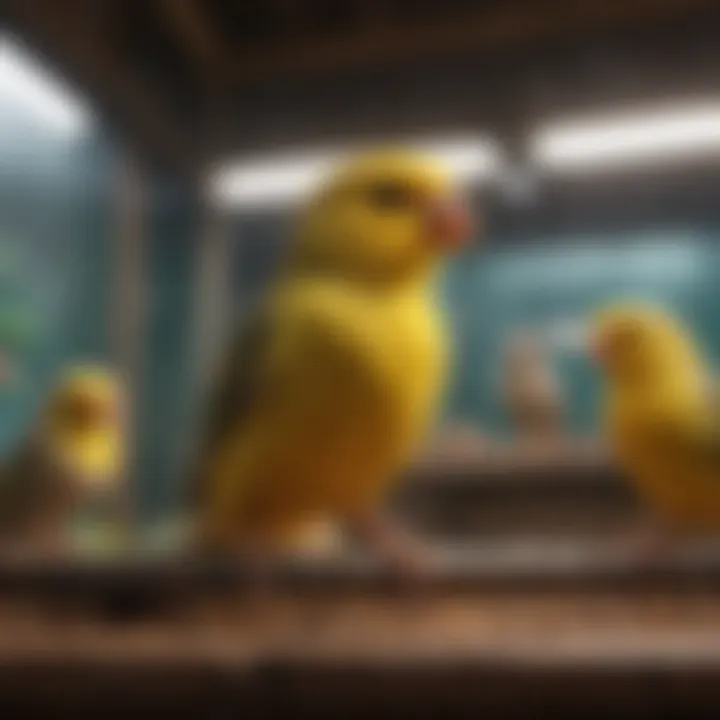
A breeding box, which should be around 6 x 6 x 6 inches, makes a perfect home for the expectant canaries. Place the box in a quiet, undisturbed area of the cage. The location matters because a stressed-out female may abandon her clutch altogether.
Environmental Factors Affecting Breeding
Understanding the environmental factors that affect canary breeding is crucial for ensuring a healthy and successful breeding process. Canaries are sensitive creatures, and their breeding outcomes can significantly depend on their surroundings. Proper attention to their environment not only fosters healthy offspring but also promotes the overall wellbeing of the breeding pairs. Factors such as temperature, humidity, light exposure, and cage setup all play integral roles.
Optimal Conditions for Breeding
Creating the right environment for breeding canaries involves meeting specific conditions. The right temperature is key; ideally, the breeding area should be between 70°F and 75°F (21°C to 24°C). This warmth mimics their natural habitat and encourages mating behaviors.
Humidity is also a vital element. Canaries thrive in moderate humidity, around 40% to 60%. Higher levels can lead to respiratory issues, while very low humidity can dry their skin and feathers.
Lighting is another factor that should not be overlooked. Canaries are photoperiodic birds, meaning they rely on light for their breeding cycles. During the breeding season, aim for 12 to 14 hours of light each day, using full-spectrum bulbs to simulate natural daylight. This can help to trigger hormonal changes necessary for courtship and breeding.
Organizing the cage setup is equally essential. Ensure that the cage is spacious and has a variety of perches and nesting materials to encourage natural behaviors. Providing areas for privacy, like small boxes or dense foliage, can give the female a sense of security when she’s preparing to lay eggs. Regular cleaning of the cages also contributes significantly to their health and the hygiene of the breeding environment.
Seasonal Influences on Breeding
Seasons significantly influence canary breeding, and understanding these cycles can lead to better outcomes. Spring and summer are typically seen as the prime breeding seasons for canaries. During these times, light levels increase, mimicking their natural triggers for breeding. Many owners notice that canaries are more active and vocal during these seasons, which can be taken as a sign of readiness to breed.
In contrast, autumn and winter can bring on a natural decline in breeding activity. Breeding pairs might seem less interested, and females may not lay eggs during these colder months. This doesn’t mean you have to stop providing optimal conditions, but you may need to adjust your expectations.
To harness seasonal influences positively, moderate changes in daylight exposure can help mimic these natural shifts. Gradually reducing the light in the fall might encourage canaries to rest and prepare for the next breeding season without stressing them.
"Creating a nurturing environment for your canaries is like setting the stage for a well-orchestrated performance; every detail counts, from light to space to seasonal rhythms."
Ultimately, being attuned to seasonal changes not only enhances breeding success but also enriches the lives of these vibrant birds. Paying attention to their environment will ensure that they thrive and successfully raise their young.
Care During Breeding
Caring for canaries during their breeding period is crucial in ensuring the success and health of the breeding process. It's not merely about providing the right environment; it also encompasses a series of specific practices tailored to support these birds in their most sensitive phase of life. Proper care can help to increase the likelihood of successful mating, boost the health of the chicks, and promote the well-being of the breeding pairs.
Nutrition for Breeding Pairs
When it comes to canaries, nutrition plays a vital role, especially during the breeding season. Pairs that are in the process of breeding need a diet that goes beyond the regular seeds; they require a well-rounded mix to support their reproductive health. This includes higher protein levels, essential vitamins, and minerals. Here are some important points to consider:
- High-Quality Seed Mix: Start with a premium seed blend formulated for breeding canaries, rich in protein.
- Fresh Greens: Offer plenty of fresh vegetables like spinach, kale, and broccoli. These not only provide necessary nutrients but also hydration.
- Protein Sources: Supplement their diet with boiled egg, crushed mealworms, or specialized breeding pellets. Protein is key for egg production and overall vitality.
- Calcium and Minerals: Provide cuttlebone or mineral blocks to ensure the females get enough calcium for egg-laying. This is critical in preventing soft-shelled eggs.
- Hydration: Fresh, clean water everyday is a must. A few drops of electrolyte solution can also be beneficial, especially in stressful situations.
Establishing a nutrient-rich diet can positively impact the health of breeding pairs and their offspring.
Monitoring Health During Breeding
Keeping an eye on the health of your canaries during breeding is essential to catch any potential problems early on. The breeding period can be stressful for these birds, often leading to various health issues if not monitored carefully.
- Weight and Appetite Changes: Regularly check their weight and appetite. Any significant decrease could indicate stress or illness.
- Behavioral Observations: Watch for changes in behavior. Canaries may become more aggressive or withdrawn. This can signal discomfort or illness.
- Look for Symptoms: Symptoms such as feather plucking, lethargy, or respiratory problems need immediate attention. If you notice any of these signs, it’s best to consult an avian vet.
- Breeding History: Keeping a log of breeding cycles and any health issues in the past can be helpful. It allows you to identify patterns that might require specific interventions.
- Stress Reduction: Providing a calm environment is important. Noise, disturbances, or overcrowding can lead to stress, which may affect breeding success.
"A healthy pair of canaries equals a healthier brood. It’s like any relationship, you have to nurture it!"
Baby Canary Care
Caring for baby canaries is a vital chapter in the breeding journey, one that can significantly impact the health, well-being, and future of these sensitive creatures. Infancy is a critical period for canaries, as the right care during this stage lays the foundations for a thriving life ahead. From the moment the eggs hatch and the tiny chicks break free from their shells, their needs demand close attention.
In this section, we will delve into the essentials of baby canary care, shedding light on feeding practices and developing social skills. This knowledge will not only ensure that the fledglings grow into strong adults but also enrich the bond between birds and their caregivers.
Feeding Newly Hatched Chicks
Feed is one of the pillars of raising healthy baby canaries. Right after hatching, chicks are totally dependent on their parents for nourishment. Typically, the mother will do a good job, but sometimes, especially with large broods, additional care is needed. The easiest way to provide support is by using a high-quality hand-rearing formula designed specifically for baby birds.
Some elements to consider about their feeding include:
- Frequency of Feeding: In the first few days, chicks need to be fed every 2 to 3 hours. This is crucial because their little stomachs are tiny and they digest quickly.
- Temperature Control: The temperature of the food should be about 38-39°C (100-102°F). Too hot or too cold can cause serious problems.
- Types of Food: A mix of hand-rearing formula and finely crushed seeds or soft foods can help. Young chicks typically can’t eat hard seeds, so this gradual introduction of seeds can set a solid base for their future diet.
Important: Always ensure that feeding utensils are clean to prevent contamination. Any illness can sweep through a brood of chicks like wildfire.
Developing Social Skills
A canary’s social skills can make a significant impact on its happiness and behavior. This begins early, right from when they hatch. Young canaries learn a lot by observing their parents and siblings, so providing a harmonious environment is key.
Here’s what to keep in mind:
- Time with Parents: Allowing the chicks to stay with their parents encourages mimicry and social interaction. They’ll learn grooming, chirping, and other essential behaviors.
- Exposure to Different Sounds: Introduce them to varied sounds at a young age. This includes not just the chirping from existing canaries, but also recordings of other bird songs. This stimulation can develop their communication skills.
- Safe Space for Exploration: Once they are a bit more confident and have gained some feathers, provide them with a safe area to explore outside the nesting box. This can help with their agility and confidence when interacting with their surroundings.
In these early stages, patience is essential. Each chick will develop at its own pace. Therefore, a gentle, observant approach is necessary to ensure they adapt well and grow into well-rounded, social adult canaries.
Common Challenges in Canary Breeding
Breeding canaries can be a rewarding endeavor, but it's not all sunshine and rainbows. Understanding the common challenges in canary breeding is crucial for any breeder, novice or experienced. These challenges could affect breeding success, the overall health of the birds, and the experience the breeder gains. Facing problems such as infertility or diseases might seem daunting, but addressing these issues head-on can build a stronger foundation for your breeding program. Knowing what to look for helps in preparing and minimizing potential setbacks.
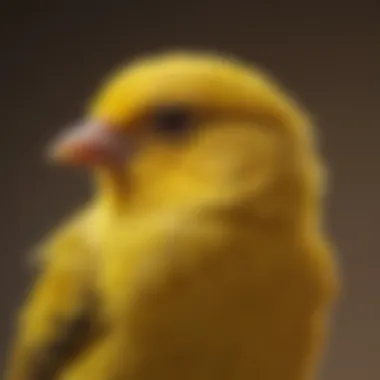
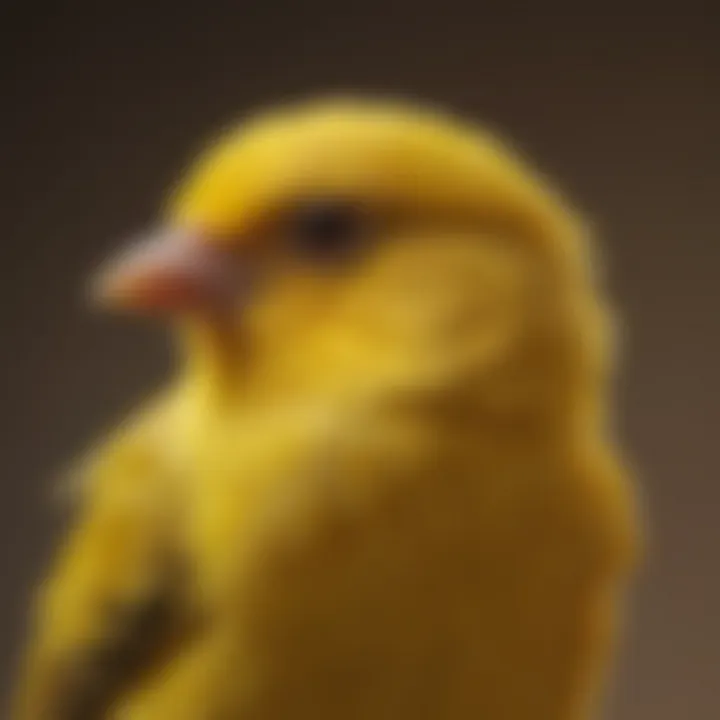
Dealing with Infertility
Infertility in canaries can throw a wrench into your breeding plans. It’s like hitting a brick wall when you've laid all the groundwork. There are several reasons why your canary pairs might not be producing eggs or why their eggs aren't hatching.
- Age of the Birds: Young canaries under the age of one year may not be mature enough to breed, while older birds may have lower fertility rates.
- Health Factors: Ailing birds could suffer from fertility issues, so regular health checks are critical. Prioritizing a health screening can help catch problems early.
- Environmental Conditions: Sometimes, the surroundings just aren’t right. Insufficient light, improper temperature, or even stress can impact breeding.
If you find yourself facing infertility, it’s essential to first examine these factors. Is the breeding environment set up for success? Make adjustments as necessary. Consulting with fellow breeders or an avian veterinarian can also provide valuable insights.
"Infertility is often a symptom of larger underlying issues that might require your attention."
Pest and Disease Management
Another major challenge in canary breeding revolves around pests and diseases. Just like any other pet, canaries are susceptible to various health threats, whether they be from parasites or viral infections. Keeping a watchful eye can prevent minor annoyances from escalating into severe problems.
Key Pests and Diseases to Watch For:
- Mites: These tiny pests can cause significant irritation and health issues. Regular cleaning of the cage and providing dust baths can keep mites at bay.
- Bacterial Infections: They can manifest in several ways, from feathery irritations to respiratory issues. Immediate veterinary advice is crucial.
- Fungal Infections: Often a result of high humidity and poor ventilation, these can be nasty. Ensuring proper ventilation often wards off such infections.
Creating a regular health maintenance routine goes a long way. Regular cleaning of housing, routine check-ups, and monitoring behavior will catch many issues early. Also, staying informed by reading articles or joining forums can aid in learning about new threats.
By being proactive in addressing infertility and pest challenges, you increase your chances of breeding success and contribute to healthier bird populations.
Ethical Concerns in Canary Breeding
Breeding canaries is not just a pursuit of joy and beauty; it also involves a set of responsibilities that cannot be overlooked. As canary enthusiasts, it’s crucial to understand the ethical landscape surrounding breeding. The practices involved in this hobby can have profound implications for the health, well-being, and genetic diversity of our feathered friends. Neglecting these ethical considerations could lead to suffering not only for the birds themselves but also for the community as a whole.
Understanding Genetic Manipulation
In the world of aviculture, genetic manipulation often surfaces as a hot topic. This refers to the selective breeding practices that aim to enhance certain traits, such as color and song, through controlled mating. While many breeders aspire toward these results, it’s important to tread carefully. The pursuit of perfection can sometimes lead to unintended consequences.
Certain manipulations can reduce genetic diversity among canaries, making them more susceptible to diseases and genetic disorders. For instance, breeding closely related birds can lead to inbreeding depression, manifesting in issues like reduced fertility and heightened vulnerability to health problems. Therefore, it’s crucial to balance the desire for beautiful, unique canaries with the need to preserve healthy genetic lines.
"Like any hobby, the pursuit of excellence in breeding must be tempered with an understanding of nature's complexities. Take heed; the quest for beauty should not come at the cost of the bird’s health."
Educating oneself about genetics and maintaining meticulous records of lineage can help mitigate these risks. It may also involve collaborating with other breeders to introduce new bloodlines, thereby enhancing genetic diversity and ensuring long-term health for the birds.
Promoting Healthy Breeding Practices
For both new and seasoned breeders, promoting healthy breeding practices is of paramount importance. This not only benefits individual birds but also bolsters the reputation of the aviculture community as a whole. Here are some essential practices to consider:
- Prioritize Health Screening: Regular health checks for breeding stock help identify any potential issues before they can affect offspring.
- Maintain Clean Environments: Ensuring that breeding areas are hygienic reduces the risk of diseases spreading among birds. This is basic, yet essential.
- Educate About Care Needs: Breeders should keep abreast of developments in canary care, from appropriate nutrition to socialization. Sharing this information fosters a community of informed breeders.
- Encourage Ethical Practices Among Peers: Advocate for ethical breeding within your community, encouraging fellow breeders to prioritize the welfare of their birds over aesthetics.
In essence, a breeder’s choices can influence the direction of future generations. By taking a responsible and informed approach to breeding practices, one doesn't just enhance their own breeding success but simultaneously contributes to the well-being of canaries worldwide.
By fostering a culture of ethical breeding practices, we create a lasting legacy that prioritizes the health and love for canaries, ensuring that future generations can enjoy these delightful companions.
The Role of Community in Breeding
Breeding canaries isn’t just a solitary pursuit; it thrives within a community. The shared knowledge and experience among breeders can be a goldmine for both novice and seasoned enthusiasts. Community involvement offers opportunities for support, education, and collaborative problem-solving. Through participation in local clubs and online forums, breeders can exchange tips, techniques, and resources that help improve breeding practices.
Joining Breeding Associations
One of the most significant benefits of joining breeding associations is access to a network of like-minded individuals who share a deep passion for canaries. These associations often hold seminars, workshops, and training sessions where members can deepen their understanding of the trade. For example, associated pairings might share techniques for maximizing genetic diversity, or a veteran breeder could provide insights into feeding and nurturing young chicks.
Benefit highlights include:
- Resources: Many associations provide literature, access to online databases, and publications focusing on latest research and trends in canary breeding.
- Mentorship: New breeders can find mentors within these groups who can provide guidance on the often daunting aspects of breeding and care.
- Networking: Building a rapport with other breeders can lead to potential collaborations or exchanges of breeding stock, allowing for an expansion of genetic traits.
Participating in Competitions
Engaging in competitions presents another avenue for breeders to showcase their work and learn from others. Competitions can serve as a barometer of breeding success, providing feedback on the quality of canaries. These events often feature categories for various breeds, colors, and even singing abilities. Notably, competition also fosters healthy rivalry, pushing breeders to excel in their practices.
Some advantages of participating include:
- Recognition: Winning or placing in competitions brings recognition, which can enhance a breeder's reputation and credibility in the community.
- Learning Opportunities: Many events include judging sessions where feedback is offered, helping breeders refine their approaches based on professional critiques.
- Social Interactions: Competitions provide a platform not just for showcasing birds but also for connecting with other breeders and enthusiasts, fostering a deeper sense of community.
"It’s through our shared experiences in the breeding community that we can elevate the standards of our beloved canaries."
Finale
In the world of canary breeding, reflection is a vital piece of the puzzle. Breeding these birds isn't just about the act itself; it encompasses a rich lifecycle from understanding their genetics to caring for the resulting hatchlings. This journey reveals much about responsibility and dedication, traits that every successful breeder must cultivate. Each song, feather pattern, and behavior becomes a testament to the breeder's choices and practices.
Breeders who take the time to reflect on their methods will find notable improvements not only in the birds’ health but also in their breeding outcomes. Considerations regarding the genetic quality of breeding stock and the assessment of environmental factors lead to better practices. This process isn’t merely transactional; it is personal and filled with learning lessons.
Key Elements to Consider:
- Health of Breeding Stock: Prioritize the well-being of your birds, as it directly impacts offspring quality.
- Environmental Factors: Recognizing seasonal influences can enhance breeding success.
- Community Involvement: Engaging with fellow breeders can provide support and insights that enrich your breeding experience.
"A flock of canaries can teach patience and kindness, not just about breeding but also about the joys of nurturing life."
In closing, successful canary breeding involves a blend of scientific knowledge and a heartfelt commitment to the birds. From the thrill of seeing the first chick hatch to the rewarding sound of a young canary serenading the room, each step taken in this journey adds depth and richness not only to life as a breeder but also to the vibrant community of canary enthusiasts. It’s a beautiful cycle that fosters respect for these charming little avians.
Reflecting on this journey allows us to appreciate the beauty in our efforts and the positive impact we can have on the lives we touch through responsible breeding. The adventure continues for those willing to learn and grow alongside their winged companions.







